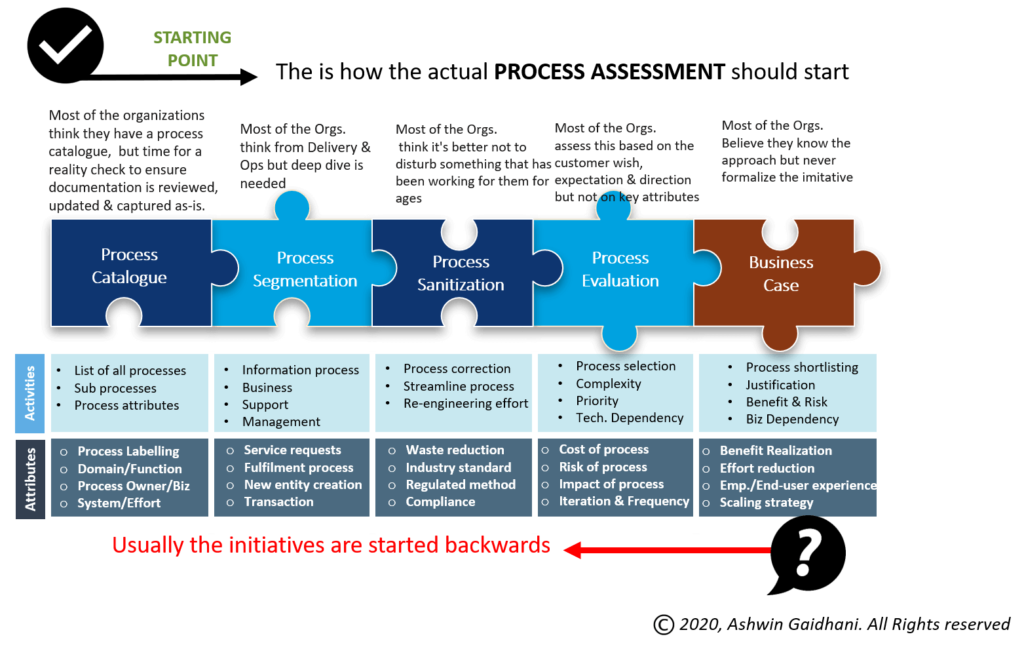
THE PROCESS
Our entire, exclusive, and inclusive business ecosystem is a mesh of actions, reactions, interpretations, and conclusions that operates in a determined sequence called PROCESS.
Processes connect every human and machine dimension of our enterprise. It is the central nervous system that carries and mobilize the information in the defined direction. Everything in the technology landscape is serving the process of capturing, storing, mapping, relating, and presenting. Again a perfect example of Digital transformation put to work at its full capacity.

In my view, DIGITAL TRANSFORMATION begins concurrently from both the ends of a straight line that represents a business entity.
- One end # External – WHO: Endusers-Customers) ~ The beneficiaries (Value recipient)
- Other end # Internal – HOW: Business-support-technology processes ~ The Method (Value generation)
Processes were physically dependent on people to execute specific actions based on business requirements developed by constant training and exercising. Eventually, the success factors were reliant on the intellect and intent of the individual executing these instructions. Now the processes are embedded into the systems (tool), which digitally guides you to perform the corresponding actions and prompts your intervention. Process experts are more and more involved in the development and designing of the process flow. We are foreseeing (if not already happening) components and modules for every process with configured metrics, computable /SLA/OLA/, and alert during every critical action.
Ultimately, all processes will be optimized as per the industry best practices, accepted response thresholds, service agreements, approved performance levels and tested business rules. We have enough data and established frameworks being followed across industries. This will lead to the standardization of almost all processes with automation as a critical lever to gradually transfer homogenous actions and engaging AI capabilities to handle the decision making powered by Analytics for inferencing and presenting the insights with a minimal human intrusion.
Most organizations should start with “Enterprise process segmentation” and “General Process segmentation” to begin the process transformation. This gives transparency in denoting the core characteristics to remodel the processes. This segmentation should already exist in the process catalog with objective attributes.

This segmentation will help you calibrated your approach to build a realistic business case to start the process transformation. Every Organization holds or must hold a process catalog.

The business case formulation will present an opportunity to simplify the processes to the highest level of relevance and amplifying the output without compromising accuracy. This simplified version of the process can be replicated in various functions and departments. This can improve the automation quality and velocity to realize faster benefits.

Process discovery – process mining is preferred in today’s environment as it has matured. We have different versions for several purposes as a standard step before introducing automation/AI capabilities. These solutions play an essential role but address various aspects that I would like to highlight and then decide which is best to fill in the gap. One has to be very clear on how you will plan the usage, application, and relevance of these process information gathering solutions. Presently we have solutions that are encompassing a little of all or at least the majority functionalities. One has to choose from options like process capture, simulation, and evaluation platforms with discretion as you are not going to solve all your problems with one tool. And you do not want to end up having all of them with minimal use adding to a lofty expenditure and unmet ROI. Not to forget, all these various platforms have particular trained & certified skillset requirements, which you will have to factor in when considering.

A conclusive move for a Digital Leader:
Every process carries specific accountability and performance constituent, which define the process efficacy and reliability. Here are the principal evaluators of a process that grants an opportunity to redesign the process in a new format.
* Cost of Process execution – emphasizes on Productivity and efficiency of processing one transaction and the relative value that it consumes to complete the iteration.
* Risk of a Process non-adherence – stresses on the mandatory activities that are crucial and may cause an adverse consequence on the compliance, information, policy, and regulatory aspects.
* Impact of the process disruption – relates to the inadequacy to complete a commitment that might act as a setback on brand reputation, customer loyalty, and commercial aspect.
- Cost of Process execution
- Risk of a Process non-adherence
- and Impact of the process disruption

The three most critical place holders to prioritize high value and high impact processes to build service resiliency, uncompromised user experience, and business continuity.
Suddenly the human aspect has gained prominence as the equation and relation of us (Humans) with technology have evolved from operator to disruptor. It is the skill that drives the technology, and talent lies with the people with a clarified-sanitized process.
Technology has become the least common multiple of the entire living and non-living strata. Businesses, customers, technology partners, and consumers thrive through hyper collaboration and connected experiences due to integrated processes.
The technology was an enabler decades ago. Then, it managed to become an Integrator a few years ago, and now it is the accelerator to transform expectations.



Leave a Reply
You must be logged in to post a comment.